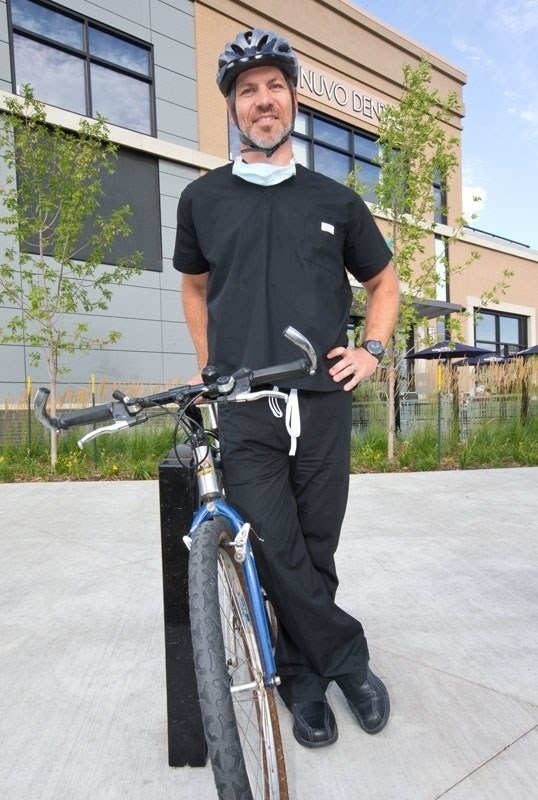By Kevin Ma
My commute to work earned me $2.22 this week.
I drive a Honda Civic hybrid, and I live six kilometres from the Gazette office. Because I biked to work instead of driving three times this week, I was able to keep the car parked at home and save about $2.22 in gas (at $1.12 a litre).
I also got to hang out with rabbits, magpies and Swainson's hawks, get a tonne of exercise, and prevent some 4.6 kilograms of greenhouse gas emissions (according to Natural Resources Canada).
Not bad for a bike ride.
Transportation and car use make up a big proportion of our carbon emissions – about 32 per cent, according to the City of St. Albert's greenhouse gas inventory report. If we're going to shrink our carbon footprint and keep the world below two degrees of warming, we need to address this sector.
"The only way we can really drive greenhouse gas emissions down is to use less fuel overall," says Scott Wilson, senior policy analyst with the Alberta Motor Association.
You could get a smaller car, for example, or replace it with a hybrid or electric model.
Try less car
Or you could, y'know, not drive.
"Not everybody needs to drive," Wilson notes, and there's a growing chunk of the population that doesn't, using bikes, buses and car-pools to get to work instead.
Colin Diener of St. Albert's Nuvo Dental says he's biked to his office year-round since December.
"I'm 41 years old. It's hard to get to the gym as I once did," he says.
Instead of doing a four-minute drive to work, he now does a 10-minute ride, getting his workout and cutting his gas bill and carbon footprint in the process.
"There are not too many negatives," he says – snowstorms are a pain, he admits.
Ben Gibson has been biking to work from St. Albert to downtown Edmonton two to three times a week since June.
"I saw it as extra exercise," he explains, and as a way to save on gas.
Gibson also carpools when he can, as it gives him a day off from driving and lets him socialize with others.
Back in the United Kingdom, he didn't even have a car, as he was able to use public transit to get everywhere. Taking the bus lets you sleep and/or read as you're chauffeured to work and gives you a chance to see interesting people, he says.
The bus isn't for everyone, but it's a lot cheaper to get a monthly bus pass than a month of gas, Wilson says. (A monthly commuter pass in St. Albert costs $112. Three 40 L fill-ups a month costs $134.40 at current gas rates.)
A 2015 Honda Civic uses 7.1 L per 100 km and creates 163 grams of CO2 per kilometre driven, reports Natural Resources Canada. A 10 km round trip in such a car creates 1.6 kg of emissions and uses $0.80 in gas.
Car-pooling with four others lets you split those costs and emissions four ways (0.4 kg and $0.20 per trip). Cycling eliminates the costs and emissions entirely.
You spend more time getting to work with the bike, but you get time back that you'd otherwise spend on your workout, Diener notes. You also get to spend more time outdoors, which he finds quite valuable.
"It's actually quite rejuvenating."
How to bicycle
If you don't already have the gear, you can get a basic commuter bike plus safety gear for about $800, says Brad Holmes of Cranky's Bike Shop.
By law, cyclists need to have a horn or bell on their bike and front and rear lights and reflectors at night. Helmets are mandatory in St. Albert and required for children in Edmonton.
Cars are definitely an issue if you're cycling, as it's easy for drivers to miss you. Wear high-visibility clothes and follow the rules of the road, Wilson says.
Gibson and Diener say proper route planning can help you avoid traffic. St. Albert and Edmonton have a vast network of trails and shared paths that can keep you safe. Try out your route on a weekend before you go to work, Diener suggests.
As for carpooling, Gibson says his workplace put up a map where people can indicate their home address and form car-pools. There are also many apps available to find drivers, such as carpool.ca.
I don't bike to work all the time, but I do so whenever I can. And when I do, my wallet thanks me.
Carbon Tracker
Step: Bike to work twice a week (20 km total).
Difficulty: Medium.
Cost: $800, if you don't already have a bike and helmet.
Payback Period: Assuming that gas is $1.12/L and you drive a 2015 Honda Civic, about 9.7 years. (You save $1.59 a week, not counting other benefits of the bike.)
Carbon Saved: 170 kg/year.
The Carbon Challenge
Climate change is happening, and it's being driven in most part due to our carbon emissions. Our carbon challenge is to reduce those emissions so that the climate of tomorrow is better than the one we have today. <br />The Carbon Challenge will profile different ways you can shrink your carbon footprint and (usually) save money every second week. <br />Got a carbon question? Drop me a line at [email protected].




